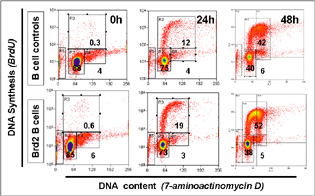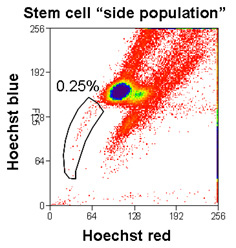Additional projects
DENIS LABORATORY — CANCER RESEARCH CENTER
 B cell malignancy. Mice that constitutively express a BRD2 transgene in their B cell lineage sporadically develop lymphoma several months after birth. These B cell lymphomas are monoclonal in their patterns of immunoglobulin gene rearrangement and show elevated endogenous cyclin A transcription. Transgenic B cells overproliferate in vitro, as established by flow cytometry analysis that measures incorporation of bromodeoxyuridine and DNA content by 7-aminoactinomycin D.
B cell malignancy. Mice that constitutively express a BRD2 transgene in their B cell lineage sporadically develop lymphoma several months after birth. These B cell lymphomas are monoclonal in their patterns of immunoglobulin gene rearrangement and show elevated endogenous cyclin A transcription. Transgenic B cells overproliferate in vitro, as established by flow cytometry analysis that measures incorporation of bromodeoxyuridine and DNA content by 7-aminoactinomycin D.

Brd2 functions at least in part through a pathway that targets the gene cyclin A and affects S phase events. A brd2 knockout mouse is currently under development, in which we expect to observe defects in cell cycle progression and proliferative responses to mitogens.
Stem cell reconstitution. To test this idea in the immune system, we have reconstituted mice with hematopoietic stem cells transduced with lentiviral expression vectors for Brd2 overexpression or Brd2 knockdown and compare results to empty vector lentivirus, using expertise that Drs. Darrell Kotton and Alan Fine of the BU Pulmonary Center have generously shared with us.

We have exploited the low Hoescht 33342-staining properties of hematopoietic stem cells, which use an ABC-type transporter to efflux the Hoechst dye, to isolate these stem cells. These cells are termed “side population” cells because in flow cytometry, they are visualized off to the left side of the main population. The “side population” is transitory, not stable, and its appearance and visualization by flow cytometry is a function of the concentration of Hoechst, the time of incubation, the quality of the cells, and other important factors like temperature and pH. The side population cells, either lentivirally transduced or control, can reconstitute mice with high efficiency.
Transcriptional and proteomic profiling of lymphomas. Genome-wide transcriptional profiling of the Brd2-driven murine lymphomas identifies a signature that is most similar to human diffuse large B cell lymphoma, one of the more aggressive forms of non-Hodgkin’s lymphoma (NHL). We collaborate with Dr. Marc Lenburg of the BU Microarray Core and use this approach to identify new biomarkers for human lymphomagenesis, detection of relapse and risk assessment. In functional terms, we have exploited this technology to study resting or proliferating normal B cells and proliferating malignant B cells. We identified two major axes of gene expression: one group of genes significantly differentially expressed between resting and proliferating normal cells (a “proliferation signature”, and another group of genes differentially expressed along an orthogonal axis unrelated to normal proliferation (a “cancer signature”).
 We have taken this idea and used state of the art methods in mass spectrometry and proteomics to develop proteomes and phosphoproteomes of lymphomas. We enjoy a close collaboration with Drs. Cathy Costello, Mark McComb and colleagues at the BU Mass Spectrometry Resource to perform these experiments. We derive two dimensional reference maps of B cell proliferative states, and then use MALDI and liquid chromatography-tandem mass spectrometry (LC-MS/MS) of tryptic peptides for online database identification of protein candidates. We are developing new proteomic signatures of lymphoid malignancy and establishing proteomic 2D reference maps for resting, activated and malignant B cells taken from transgenic mouse spleen. Based on these maps, we have been able to conclude that, by analogy with transcriptional profiling, a relatively simple set of protein biomarkers defines proliferating malignant B cells in mice, as distinct from proliferating normal B cells. New instrumentation, including Orbitrap spectrometers, has increased our ability to derive phosphoproteomic information about deregulated signal transduction pathways in B cell lymphomas.
We have taken this idea and used state of the art methods in mass spectrometry and proteomics to develop proteomes and phosphoproteomes of lymphomas. We enjoy a close collaboration with Drs. Cathy Costello, Mark McComb and colleagues at the BU Mass Spectrometry Resource to perform these experiments. We derive two dimensional reference maps of B cell proliferative states, and then use MALDI and liquid chromatography-tandem mass spectrometry (LC-MS/MS) of tryptic peptides for online database identification of protein candidates. We are developing new proteomic signatures of lymphoid malignancy and establishing proteomic 2D reference maps for resting, activated and malignant B cells taken from transgenic mouse spleen. Based on these maps, we have been able to conclude that, by analogy with transcriptional profiling, a relatively simple set of protein biomarkers defines proliferating malignant B cells in mice, as distinct from proliferating normal B cells. New instrumentation, including Orbitrap spectrometers, has increased our ability to derive phosphoproteomic information about deregulated signal transduction pathways in B cell lymphomas.
We employ these methods to investigate the malignancy-specific signature of human primary tumor tissue from patients diagnosed with lymphoid malignancy in an ongoing IRB-approved clinical study. This approach greatly simplifies proteomic biomarker discovery for lymphoid malignancy. In the illustration, the total ion chromatogram (TIC) for a tryptic digest of lymphoma proteins is compared to the single ion chromatogram (SIC) at a mass-to-charge ratio of 590.7; this peak in the LC elution profile happens to contain peptides that unambiguously identify histone H4 as part of the Brd2 multiprotein complex.
Pharmaceutical development and experimental therapeutics for lymphoid cancers. We are investigating potential new therapeutic targets and anti-cancer pharmaceutical agents, specifically telomeric DNA-based oligonucleotides (T-oligo), as treatments for lymphoma. T-oligos have had major success as a novel therapeutic approach to NHL in several of our Brd2 mouse model systems, and they cooperate well with the existing therapy for human lymphomas, called CHOP. We have initiated a translational study with T-oligo, under an IRB approved protocol, with patients at Boston Medical Center who are undergoing treatment for NHL.
Check the clickable link below to find this trial:
Telomere DNA-Based Experimental Analysis of Lymphoid Malignancy
Brd2 transcriptional control of adipogenesis and inflammation. ‘Leaky’ knockout of Brd2 in mice leads to a hypomorphic phenotype. The mice quite surprisingly develop severe obesity on regular chow, which is an extraordinary enough phenotype for a disrupted MHC II gene, but these mice also manage to avoid whole-body insulin resistance and Type 2 diabetes. This observation has potentially major significance for immunology because a cohort of obese humans who are known to avoid Type 2 diabetes also tend to show a reduced inflammatory profile, but the mechanisms that confer this protection are not well understood. It is well known that alleles in the MHC II locus are linked to Type 1 diabetes, specifically through the mobilization of autoimmune processes. Our new observations also suggest that innate and adaptive immune responses are also important for body energy balance and disposal of blood glucose through the ability of Brd2 to regulate the chromatin status of key target genes for adipogenesis, inflammation and growth. We also suspect that polymorphism of BRD2 and related genes may play an important role in human development.

